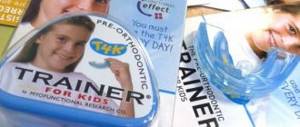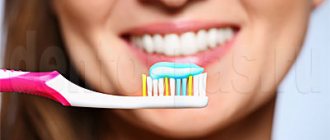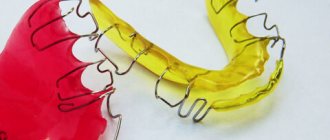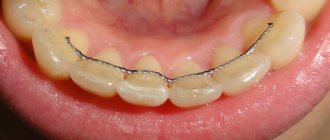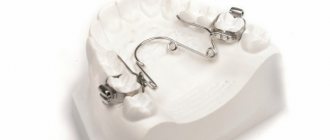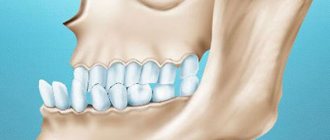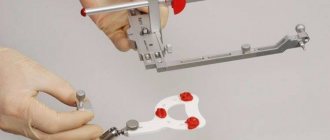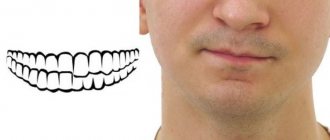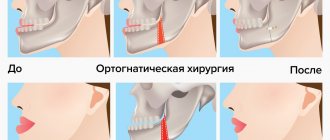How is the bite formed?
The process of bite formation is long - from birth to adolescence. There are 5 periods.
- Initial (up to 6 months): no teeth, the upper jaw is larger in size than the lower jaw. At this time, an active feeding process is extremely important for the proper development of the jaw apparatus.
- Emerging temporary bite (6 months - 3 years): baby teeth and a bite appear, but it is still temporary. This stage is accompanied by inflammation of the gums, a rise in temperature, often grinding of teeth (bruxism), and emerging teeth may be crooked. It is important to maintain hygiene without taking any orthodontic measures.
- Formed temporary occlusion (3 - 6 years): baby teeth have erupted and can close in different ways, jaw growth continues. This is the time of active use of teeth. Characteristic wear of temporary teeth is considered normal before the upcoming change.
- Changeable dentition (6-12 years): jaw growth, loss of baby teeth and appearance of permanent teeth. Often new teeth, especially the lower ones, erupt unevenly. During this period, it is necessary to decide on a plan for further correction of the bite.
- Permanent dentition (12 - 15 years): replacement of milk teeth with permanent ones, all 28 teeth are visible, no wisdom teeth. The period is most favorable for orthodontic treatment.
In order for the bite to form correctly, there must be careful attention to teething, oral hygiene, and a timely plan to correct emerging problems.
Stages of formation
In order to understand what pathological bites are, you need to understand what factors provoke their appearance. Formation occurs from the moment of birth and lasts until adolescence (approximately 16 years).
It all starts with the appearance of the first incisors. The bite is determined after the replacement of milk teeth with molars. It is influenced by external factors and heredity. The most common reason is prolonged sucking of the nipple or objects that replace it. It is best to breastfeed the baby and wean it after one year.
The baby's sleep should be calm, breathing should be through the nasal cavity, and the mouth should be closed. Problems can arise due to cleft lip and palate (in the common sense, such a defect is called a “cleft palate”), adenoids, and so on. All this must be treated immediately and the situation must not be allowed to worsen. Sometimes the eruption of molars is delayed, and this causes the row to shift. As a result, an incorrect bite is formed.
Orthodontics is a branch of dentistry that deals with the comprehensive study of dental anomalies. It is this doctor who is able to determine the type of bite and prescribe corrective measures.
Correct teeth bite
An ideal orthognathic bite implies the presence of the following features:
- The upper dental arch is slightly inclined forward and has the shape of a semi-ellipse, the lower, in the shape of a parabola, is slightly backward.
- When the jaws close, each upper tooth contacts the opposite tooth below.
- There are no obvious gaps between the teeth.
- The upper teeth overlap the lower teeth by about a third of their height.
Despite the fact that there are the above parameters for a perfect smile, the question “What should be the bite of the teeth?” cannot be answered unambiguously. In addition to the orthognathic bite, modern orthodontics allows for several options for the normal structure of the dentition and the location of the jaws.
Orthognathic
The upper row of teeth overlaps the lower one by 30% of the height, there are no gaps between the teeth or spaces between the rows.
Biprognathic
The dentition is slightly directed towards the vestibule of the mouth.
Progenic
The lower jaw moves forward slightly.
Straight
When the jaws close, the upper teeth come into contact with the lower cutting edges.
general information
In dentistry, types of occlusion refer to the position of the teeth in the mouth when the jaws meet. This contact is called occlusion. Central occlusion is when the teeth meet at most points, the head of the mandible is at the base of the articular tubercle, and the middle of the face should correspond to the passing line between the main incisors.
Normal (physiological) types of occlusion include:
- straight;
- orthognathic;
- biprognathic;
- progenic.
Each of them has its own characteristics. Violations can be determined at home. An exemplary closure is considered to be the option when the upper row of teeth overlaps the lower ones by no more than a third. The contact itself is tight. In addition, the shape and size of the teeth are taken into account. The upper jaw is characterized by a slight inclination towards the lips, and the lower jaw - towards the tongue.
Malocclusion of teeth
Look at your reflection in the mirror. If you notice an excessively protruding upper or lower lip, teeth that “overlap” each other, or gaps between the dentition when the jaws are closed, this is a clear reason to consult a specialist. Descriptions of dental anomalies and photographs of teeth with malocclusion pathologies are presented in the table below.
Distal (prognathic)
In a distal bite, the upper jaw is more developed than the lower jaw.
Mesial (medial)
With a mesial bite, the lower jaw is pushed forward.
Cross
In a crossbite, the rows of teeth intersect in the manner of scissors when the jaws close.
Deep
In a deep bite, the upper teeth significantly overlap the lower teeth.
Open
The presence of pronounced gaps between the dentition when the jaws are closed indicates an open bite.
Causes of anomalies
Deep pathology of occlusion - the arrangement of the dentition in the closed state is incorrect. Such defects are not congenital; they appear in the first year, developing as they grow older, reaching varying degrees of curvature in the absence of cases of therapeutic intervention. The natural features of the structure of the maxillofacial bones of newborns are that the size of the upper jaw is slightly larger than the lower jaw. Correct development corrects this shape during growth due to the fact that the lower jaw works most energetically during feeding and contact with the breast. Artificial feeding of a baby carries the risk of pathology.
There are 5 main reasons for the appearance of anomalies.
- Artificial feeding
The reason is parental ignorance. An excessively large hole at the nipple on an open bottle leads to an almost complete absence of mandibular work. It does not develop as necessary; the baby will not cope with the occlusion naturally. We need nipples that have a small hole so that the lower jaw actively develops during feeding and becomes strong.
- Head position during sleep and feeding
The same posture of the baby's head while eating or sleeping leads to some pathological problems. The correct parental task is to ensure that this position is constantly changed so that normal jaw development occurs without bone habituation.
- Bad habits
A baby who is used to a pacifier or who sucks his finger all the time sometimes develops space between his teeth and jaws. The same problem occurs when the body is positioned incorrectly, especially when posture is poor. If you cannot find a solution to these problems, you need to seek medical help. The specialist will recommend a set of devices for various prevention of defects, as required by age and individuality.
- Consequences of diseases
A stuffy nose forces a baby prone to frequent rhinitis or sinusitis to breathe through the mouth. The lower jaw is constantly slightly open, therefore preventing the normal development of the maxillofacial bones. Improper occlusion appears, and an “adenoid” type of face may develop.
- Heredity
There are people who are prone to incorrect jaw position due to genetic reasons. Even if only one of the parents has a deficiency, it grows in each new generation.
Bite in the absence of teeth
A person without teeth has problems with the functioning of the temporomandibular joints, facial aesthetics deteriorate, and wrinkles appear due to loss of skin tone. To avoid unpleasant consequences, it is necessary to restore the bite using a complete denture made using a special technique.
Bite restoration with complete dentures
- The central ratio of the jaws is determined - the position of the lower jaw in relation to the upper in three planes: vertical, sagittal and transversal. The role of the dentition is played by wax rollers.
- Measurements are taken using a device consisting of an external facebow-ruler and an intraoral plate with a flat frontal part and curved distal parts.
- The plaster model marks the boundaries of the future structure, the line of the middle of the alveolar process, the tubercles of the upper and lower jaw, and the midline.
- Artificial teeth are placed in such a way that when you smile, the part of the prosthesis that imitates the gum is not visible.
Bite formation in children
Parents live with the attitude: until the temporary teeth are replaced by molars, there is no need to observe the correct jaw position. But this is wrong, because the formation of occlusion begins from birth. Occlusion in children is characterized by the passage of several phases.
From birth to six months, a small person does not yet have teeth, but active jaw development is underway. In newborns, the development of the lower jaw is less, but after six months, if he was breastfed, the jaw size almost evens out. The main reason for proper jaw development is breastfeeding. When a baby drinks from a bottle, you need to make sure that the nipple hole should be small. This will encourage him to use his jaw. It is also important to hold the baby's head correctly during feeding.
From 6 months to 3 years, temporary occlusion develops. The growth of all milk teeth begins, which, even when they erupt, can be positioned correctly or incorrectly. When baby teeth are being cut, the parent's task is to ensure the absence of bad habits that interfere with jaw development (thumb sucking, tongue sucking, other objects). During this period, the upper incisors are labile, so regularly holding something in the mouth can displace them and create gaps between them. To correct bad habits, there is a device - a trainer, a plate. From the age of 9 months, you need to wean your baby off the pacifier by systematically adding food that requires chewing to the menu.
From 3 to 6 years, intensive jaw growth occurs, external defects become more noticeable. If it is too deep, when the upper jaw is significantly protruded above the lower jaw, solid food must be offered so that the chewing movement develops. Active chewing correctly forms the lower jaw, increases blood flow, which leads to the growth of dental units and alveoli. To correct teeth, removable braces have been invented for children with temporary teeth. Then the temporary teeth fall out and are replaced by molars. In the case when all the children’s teeth have been replaced, but pathology has arisen, a good age for its correction is 11 - 13 years. Active dental growth provides the prerequisites for correction and a favorable change in the dental arch.
| Name of service | Price, rub.) |
| Consultation with an orthodontist | 500 |
| Single-jaw removable apparatus (medium complexity) | 16000 |
| Single-jaw removable appliance (complex) | 25000 |
| Aparta Klammt | 25500 |
| Andresen apparatus | 25000 |
| Twin-Block device | 32700 |
| Cotter pin (disconnector) | 18800 |
| Frenkel apparatus | 42000 |
| Quad-Helix device | 24200 |
| B-Helix device | 24200 |
| Relaxing mouthguard (splint) | 107700 |
| Elastic positioner | 122700 |
| Single-jaw removable retainer-type apparatus | 22400 |
| Standard functional device | 27600 |
| Treatment of malocclusions on the vestibular plate | 8700 |
| Treatment of malocclusion using a simple vestibular plate “MUPPY” | 5200 |
| Treatment of malocclusions on the complex vestibular plate “MUPPY” | 15000 |
| Soft two-jaw mouth guard (positioner) | 15800 |
| Invisible retainer | 7500 |
| Modified mouth guard | 10500 |
| Mouthguard for bruxism (single-layer) | 10000 |
| Mouth guard for bruxism (double-layer) | 12000 |
| Individual design of a removable device | 6000 |
| Occlusal splint Stars Smile | 47000 |
| Impressions (taking impressions) with alginate mass | 1450 |
| Impressions (taking impressions) with silicone mass | 1800 |
Repair | |
| Repair of single-jaw apparatus | 5000 |
| Repair of a single-jaw apparatus with the addition of element(s) | 6800 |
| Repair of double jaw apparatus | 12000 |
| Repair of a two-jaw apparatus with the addition of element(s) | 10000 |
| Adding 1st expansion screw | 2500 |
| Repair or correction of a reducing splint splint | 34200 |
Bracket systems | |
| Combined bracket system (2 rows) | 32000 |
| Metal bracket system, Gemini, ZM (USA) (1 dentition) | 11000 |
| Metal bracket system, Gemini, ZM (USA) (two rows) | 22000 |
| Metal bracket system VICTORY ZM (USA) (one row of teeth) | 18000 |
| Metal bracket system Damon Q, ORMCO (USA) (1 row) | 35000 |
| Ceramic bracket system Clarity, ZM (USA) (two rows of teeth) | 40000 |
| Ceramic bracket system ZM (USA) (2 rows) | 49000 |
| Ceramic combined bracket system ZM (USA) (two rows of teeth) | 55000 |
| Ceramic bracket system (chameleon) FORESTADENT Germany) (2 rows) | 30000 |
| Sapphire bracket system Inspire Ice, ORMCO, (USA) (two rows) | 55000 |
| Damon Clear-combined, ORMCO (USA) (2 dentitions) | 90000 |
| Ligature-free self-regulating bracket system FORESTADENT (Germany) (two rows) | 34000 |
| Self-regulating lingual brace system FORESTADENT (Germany) (one row of teeth) | 50400 |
Treatment with braces | |
| Indirect fixation of braces on one row of teeth | 10000 |
| Installation of braces (1 row of teeth) | 11000 |
| Revisit (1st row) | 2500 |
| Repeat visit (two rows of teeth) | 5000 |
| Removing the bracket system and fixing the retainer (one row) | 7500 |
Treatment with braces (installation of individual elements) | |
| Physiological separation (1 tooth) | 100 |
| Grinding the contact surface (1st tooth) | 100 |
| Hygienic treatment (1 tooth) | 150 |
| Fitting and correction of the bandage ring | 300 |
| Fitting and fixing the bandage ring | 450 |
| Fixing the button and bracket (except ORMCO products) | 500 |
| Fixation of 1 Damon Clear bracket, ORMCO (USA) | 5000 |
| Fixation of 1 Damon Q bracket, ORMCO (USA) | 3000 |
| Fixation of 1 Inspire Ice bracket, ORMCO (USA) | 2500 |
| Arc fitting | 250 |
| Fixing the arc | 1500 |
| Ligature application | 100 |
| Fitting an additional arc or spring | 1500 |
| Activating an additional arc or spring | 750 |
| Installation of a preformed spring | 150 |
| Bending the stop bend | 150 |
| Bending a loop (spring) on an arc | 450 |
| Fixed appliance correction | 150 |
| Forsus device | 36000 |
Removing individual elements | |
| Removing the bracket/button/bandage ring | 300 |
| Removing the arc | 150 |
| Removing the arch (for non-ligature braces) | 1500 |
| Removing the ligature | 100 |
Retention stage | |
| Removal of the bracket system and fixation of a non-removable wire retainer (1 row of teeth) | 7500 |
| Fixed wire retainer (for 1 tooth with fixation) | 1000 |
| Fixed fiberglass retainer (for 1 tooth with fixation) | 1500 |
| Retainer repair (1st tooth) | 500 |
| Installation of an orthodontic ring with a loop | 7000 |
| Retention mouth guards (1 row of teeth) | 7500 |
Treatment using braces (installation of individual elements for patients of a third-party clinic) | |
| Physiological separation (1 tooth) | 300 |
| Grinding the contact surface (1st tooth) | 600 |
| Hygienic treatment (1 tooth) | 300 |
| Fitting and correction of the bandage ring | 600 |
| Fitting and fixing one ring | 450 |
| Fixing the button and bracket (except ORMCO products) | 2100 |
| Arc fitting | 600 |
| Fixing the arc | 3500 |
| Ligature application | 300 |
| Fitting an additional arc or spring | 2900 |
| Activating an additional arc or spring | 1450 |
| Installation of a preformed spring | 300 |
| Bending the stop bend | 300 |
| Bending a loop (spring) on an arc | 1000 |
| Fixed appliance correction | 300 |
Removal of individual elements (for patients of a third-party clinic) | |
| Removing the bracket/button/bandage ring | 600 |
| Removing the arc | 300 |
| Removing the arch (for non-ligature braces) | 5300 |
| Removing the ligature | 300 |
Fixed retainer (for patients of a third-party clinic) | |
| Wire retainer (for 1 tooth with fixation) | 1500 |
| Fiberglass retainer (for 1 tooth with fixation) | 2000 |
| Retainer repair (for 1 tooth with fixation) | 500 |
Treatment with aligners | |
| Set of mouth guards “Star Smile” – 1st category | 50000 |
| Set of mouth guards “Star Smile” – 2nd category | 85000 |
| Set of mouthguards “Star Smile” – 3rd category | 150000 |
| Treatment with “Star Smile” aligners | 3000 |
| Repeated visit during treatment with Star Smile aligners | 0 |
| Transparent retainers “Star Smile” (1 pair) | 17300 |
| Transparent retainers “Star Smile” (2 pairs) | 24600 |
| Making an aligner in case of loss or breakage (1 jaw) | 9600 |
| Treatment using the Incognito TM bracket system | |
| Additional research during treatment with the Incognito TM bracket system (calculation, analysis, casts, model making, special photo, etc.) | 12000 |
| Bracket system Incognito TM | 300000 |
Treatment with the Incognito TM bracket system | 144000 |
| Removal of the Incognito TM bracket system with installation of a retainer (dentition) | 12000 |
| Manufacturing and fixation of one element of the Incognito TM bracket system | 9600 |
Bite after wisdom tooth removal
Some doctors are convinced that wisdom teeth are an atavism and must be gotten rid of. In ancient times, they were used to chew tough foods, such as raw meat. With the development of civilization, the human diet changed, his jaw began to gradually decrease - and the “eights” turned out to be superfluous. Most often, before starting to correct the bite, wisdom teeth are removed. This frees up space for the correct formation of rows, and the result of teeth alignment will be much better.
What affects the bite of teeth?
The negative impact of defects in the dental system on the condition of the entire organism has been repeatedly proven by scientists. The list of identified health risks is impressive even for ardent optimists.
- Due to improper distribution of the chewing load, tooth enamel wears off faster, teeth begin to react painfully to cold and hot, their necks become exposed, and noticeable gaps form between the teeth.
- Diseases of the temporomandibular joints occur, accompanied by headaches and a characteristic clicking sound when the jaws move.
- The aesthetics of the face suffers: its proportions change, wrinkles form, teeth become crooked, and the smile becomes unattractive.
- It becomes difficult to bite food, chewing functions are disrupted, causing diseases of the gastrointestinal tract.
- Speech defects appear, facial expressions are distorted, and self-esteem decreases.
- Crowding and crooked teeth cause accelerated tooth decay due to frequent chipping and carious lesions.
- The oral mucosa is injured - cheeks, gums, tongue, and the tissues of the oral cavity become inflamed.
- The quality of breathing deteriorates, which leads to diseases of the nasopharynx, trachea, and hearing aid.
How to prevent an anomaly from occurring
The most important preventive measures when types of bite are formed:
- promptly identify children with a congenital anomaly or poor heredity, or insufficient breathing through the nose;
- a pregnant woman needs to eat properly, follow a timely sleep schedule, and eat;
- carry out the prevention of rickets, which injures bones, and other childhood diseases that lead to developmental disorders;
- carry out the main points of breastfeeding and feeding a baby with a bottle;
- constantly monitor the correct position during sleep (free posture without tension, the head should not be thrown back, without a fist under the cheek, etc.);
- form beautiful posture;
- use the pacifier to a minimum;
- fight children's bad habits (thumb sucking, tongue sucking, toys, other foreign objects).
An important role is given to the rehabilitation of any dental diseases, gums, and oral cavity. If temporary teeth are lost untimely, this will negatively affect the occlusion of an adult.
Treatment of dental malocclusion
How to change the bite of teeth? Pathologies of the dental system can only be eliminated through orthodontic treatment. An exception is the correction of a low bite, when the height of the teeth decreases with age due to their wear. In such cases, the bite is corrected by dental prosthetics with crowns or veneers, as well as by implantation. Other anomalies of teeth and bite can be removed at any age with special orthodontic structures or through surgical intervention.
However, maxillofacial operations are performed only in case of serious deviations from the norm. Usually, to correct dental malocclusion, doctors suggest correction with braces or aligners.
Now that you know about all the health risks that can cause pathologies of the dental system, and how to correct your dental bite, all that remains is to take specific actions. Even if at first glance it seems that your teeth are straight, make an appointment with an orthodontist. Diagnosing the condition of the dentition will help maintain the health of other organs and systems. And timely orthodontic treatment will make your smile more attractive and significantly reduce the number of future visits to the dentist.
Bibliography
Kurlyandsky V. Yu. Orthopedic dentistry, Atlas, vol. 2, p. 110, 155, M., 1970; aka, Orthopedic Dentistry, p. 12 and others, M., 1977; Okushko V.P. Anomalies of the dental system associated with bad habits and their treatment, M., 1975; Guide to prosthetic dentistry, ed. A. I. Evdokimova, p. 246, M., 1974; Handbook of Dentistry, ed. A. I. Rybakova and G. M. Ivashchenko, p. 353, 302, M., 1977; Uzhumetskene I. I. Research methods in orthodontics, M., 1970.
L. V. Ilyina-Markosyan.
